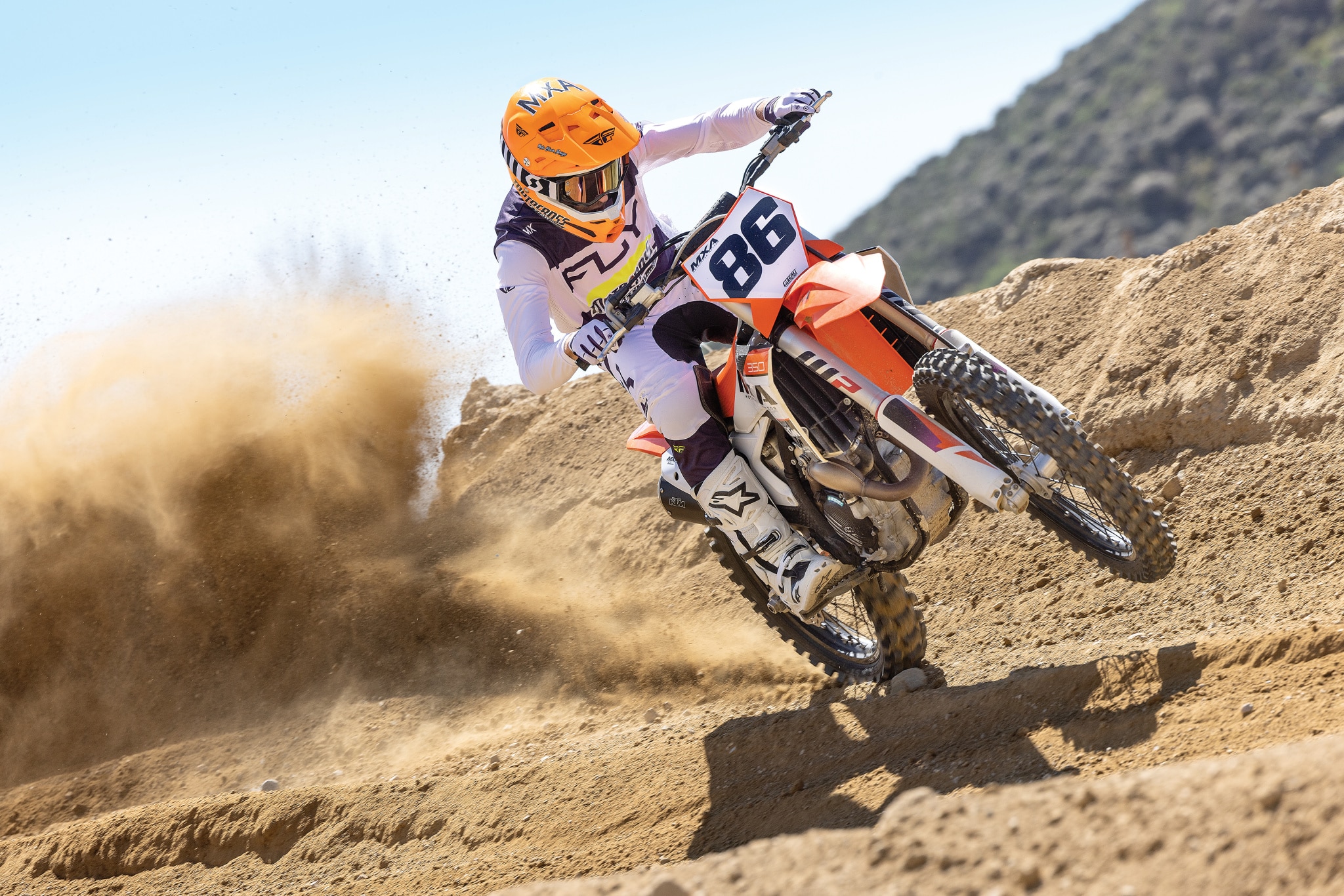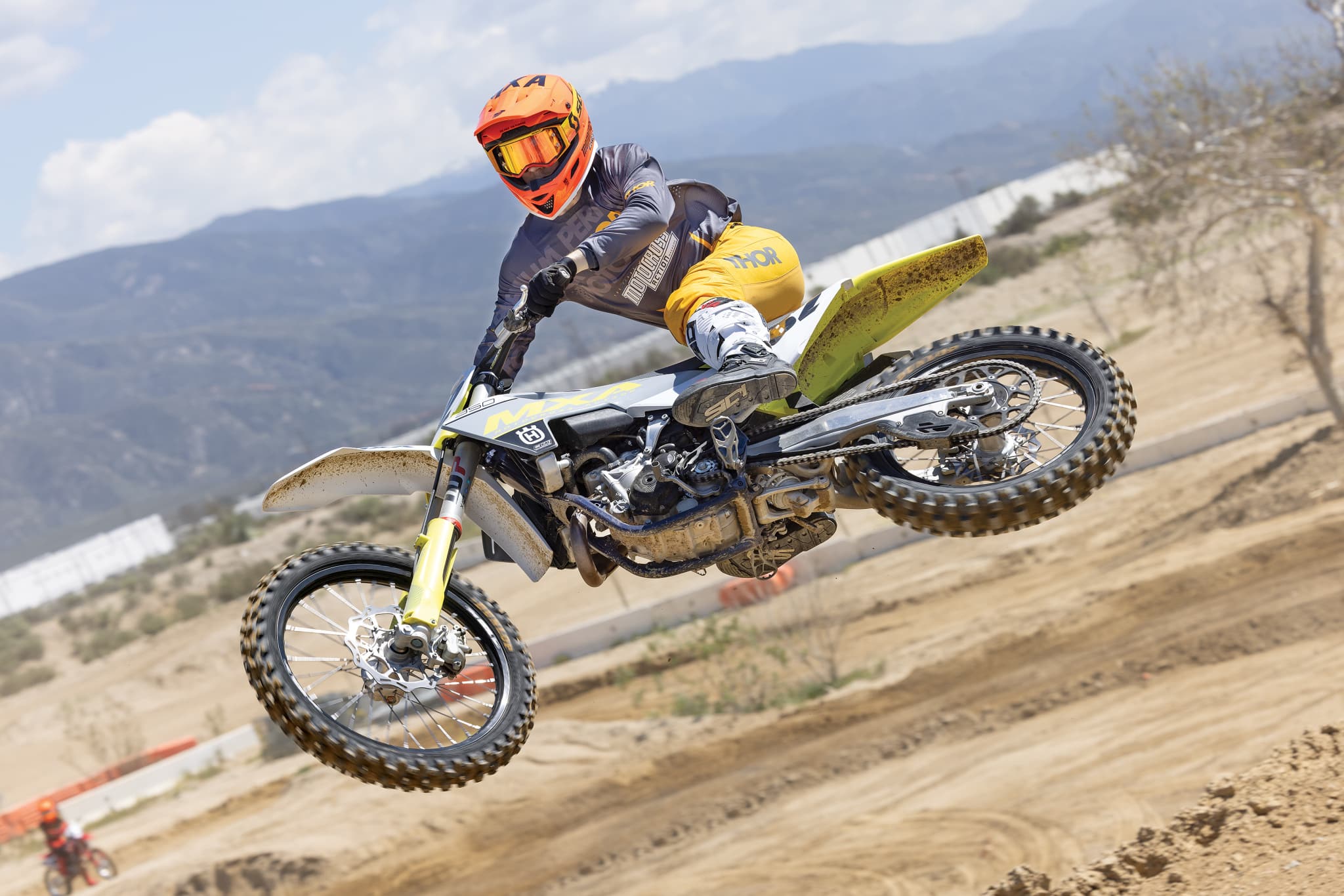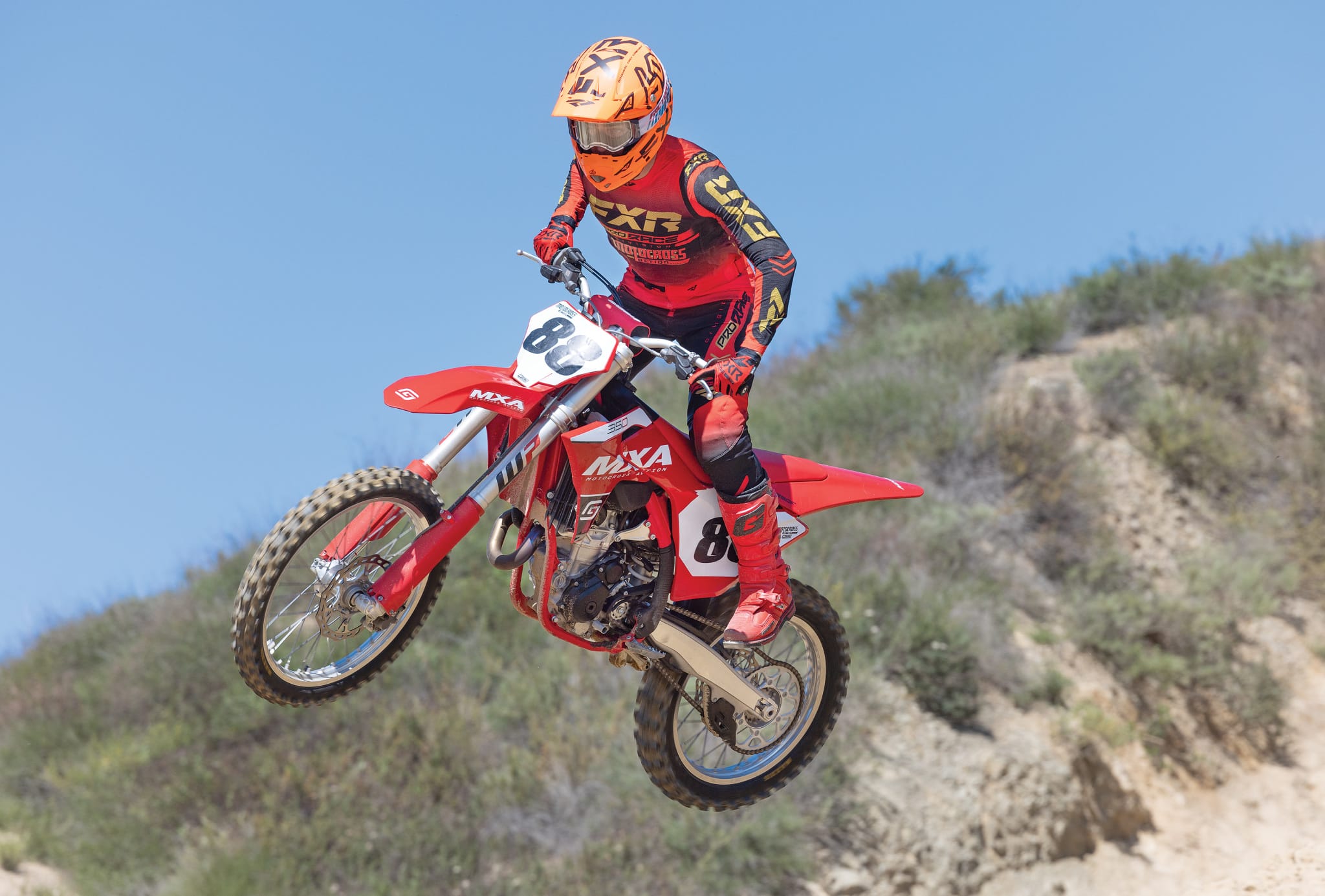2024 MXA 350 SHOOTOUT: GASGAS MC350F VS. HUSQVARNA FC350 VS. KTM 350SXF
Q: WHY DID THE MXA GANG MAKE JOKES ABOUT DOING A 350CC FOUR-STROKE SHOOTOUT A FEW YEARS AGO?
A: It seemed funny to us because, for the first five years, there was only one 350cc four-stroke—the 2011–2015 KTM 350SXF—so there was nothing to shoot it out against. In truth, there was a another brand of 350cc bike built in 2014, but it was not imported into the United States because KTM had purchased Husqvarna in 2013 and didn’t have enough time to roll out a full complement of new Austrian-built models. So, they lightened the load on the assembly-line workers by cutting the production of USA-bound FC350s to zero. Then, in the 2015 model year, Husqvarna introduced the FC350 to American consumers.
MXA could have done a 350 shootout in 2015, because by then there were two readily available 350cc four-strokes on American showroom floors, but we were reluctant to pull the trigger. Why? We had initially hoped that the Husqvarna version would be more than just a platform-shared clone of the KTM 350SXF, but the 2015 Husky FC350F shared its fellow Austrian 350’s engine, brakes, forks, swingarm, muffler, hubs, triple clamps and, in a paradoxical twist, the FC350 got a dual-map switch, while the KTM did not come with the switch, although it could be purchased separately. Strangely enough, that same switcheroo mimics the 2024 GasGas MC350F, which does not get the two-position map switch that the late-model KTM and Husqvarna 350s have, but it can be purchased separately.
We didn’t do our first “MXA 350 Shootout” against the KTM and Husqvarna until the 2018 model year. We had waited until the Austrian engineers had time to make the white 350 distinct from the orange 350, but that wasn’t achieved with a new engine, higher compression ratio, tighter gear ratios, different clutch or any mechanical doodads; it was done by manipulating how much or how little air flowed through each bike’s airbox. Motorcycle engines are essentially air pumps that draw air in, compress it, combust it and blow it out the exhaust pipe. Less air means less throttle response at low rpm, and the Husqvarna airbox delivered less air than the KTM airbox.
Q: WHY IS MXA DOING A 2024 350 SHOOTOUT IF THE THREE 2024 AUSTRIAN 350s ARE STILL IDENTICAL TO EACH OTHER?
A: That’s easy-peasy. They aren’t identical to each other anymore. Plus, the addition of a third 350cc four-stroke adds more meat to the bone. Yes, the KTM 350SXF, Husqvarna FC350 and GasGas MC350F do share the same engines, chromoly frames, triple clamps, wheels, transmissions, forks, shocks, throttle bodies, radiators, spokes and assembly line, but, big news! If you did as little as one lap on the three three-fifties, each of them would reveal its unique character.
Q: WHAT ARE THE ACTUAL MECHANICAL DIFFERENCES BETWEEN THE 2024 KTM 350SXF, HUSQVARNA FC350 AND GASGAS MC350F?
A: Here is the complete list of differences.
Age. While the KTM 350SXF has been around since 2011, the Husqvarna FC350 didn’t make its appearance in America until 2015, and the GasGas didn’t arrive on our shores until 2021.
Color palette. KTMs are orange, Husqvarnas are white, and GasGas’ are red. Each color of plastic only fits on the brand it is color-coded to. You can’t swap plastic between brands.
Plastic. To make each model stand apart from its stablemates, the gas tank, fenders, side panels, seats, subframes and front number plates are all different.
Airbox. For the first decade of Austrian Husqvarnas, Husky’s engineers borrowed the molded plastic airbox from the defunct Husaberg brand, which KTM owned and dropped once they bought Husqvarna from BMW. Husaberg’s molded airbox was the last remnant of the unique Swedish spin-off brand. Eventually, Husky switched to a traditional airbox design.
Seat. Although the KTM, Husqvarna and GasGas look like they come down the assembly line with the same seat, they don’t. Each one mounts to the frame in a different way, and each has a different texture on the seat cover.
Clutch. At one point in time the Husqvarna FC350 had a Magura clutch master cylinder, lever, slave unit and brakes, while KTM relied on 100 percent Brembo components (eventually, all three Austrian three-fifties were 100 percent Brembo). That only lasted until late 2023 and 2024, when GasGas dropped its Brembo brakes and clutch components in favor of lower-cost BrakTec parts.
Handlebars. The Husqvarna comes with ProTaper bars, while the KTM uses Neken bars. As for GasGas, it has unbranded handlebars, but they, too, are from Neken.
Rims. The Husqvarna line comes standard with black-anodized D.I.D DirtStar rims, while KTMs come equipped with black-anodized (although unlabeled) Takasago Excel rims GasGas uses unlabeled silver Takasago rims.
Q: WHAT RAE THE PERFORMANCE ENVELOPES OF THE THREE IDENTICAL THREE-FIFTY ENGINES IS MANIPULATED BY FOUR PARTS.
A: It is important to note that there are no cam, valve, piston, throttle body, fuel pump or crank differences between the 2024 FC350, MC350F and 350SXF. So, “Why do all three engines run so differently on the track?” The answer lies in four simple parts.
(1) Airflow. Each model’s airbox allows a different quantity of air into the engine. The 2024 KTM 350SXF has huge air vents on each side of the side panels and a large vent on the airbox cover. Even KTM’s optional vented airbox cover has more vents than Husqvarna’s optional vented cover. The 2024 Husqvarna FC350 looks like it has the same large air vent on the right- and left-side panels as the KTM, but those are fake vents. They are molded shut. As for the GasGas, it has a tiny air vent on the airbox cover and no optional vented cover. And, as you might guess, the GasGas engineers don’t waste their time with fake vents. In short, less air means less horsepower, but, more significantly, weaker throttle response in the low to mid transition.
(2) Exhaust pipes. The 2024 GasGas MC350F doesn’t have a resonance chamber in the head pipe, while the KTM and Husqvarna have resonance chambers to help beef up the midrange—plus, they come with unrestricted mufflers, while the GasGas has a restrictor in the muffler to tame the bark.
(3) Electronics. KTM and Husqvarna have an expansive suite of electronic aids. These include two maps (stock and aggressive), traction control, launch control and Quickshift. Conversely, the GasGas’ black box has all of the same bells and whistles embedded in it, but GasGas does not spec the switchgear to access all of it. Instead, the GasGas only comes with the mellow map activated. The switch can be purchased from PowerParts for $170.
Q: THE FIRST THING YOU NEED TO KNOW IS THAT THE HUSQVARNA FC350 AND GASGAS MC350F CAN BE MADE TO RUN EXACTLY LIKE THE KTM 350SXF ENGINE.
A: In stock trim, the white, red and orange bikes deliver their respective power uniquely. The Husqvarna and GasGas have muted low-end throttle response, which makes the KTM 350SXF feel barkier. In truth, all three engines make almost the same peak horsepower once they get closer to 11,000 rpm. A talented rider would say that low-end power isn’t really a factor in going fast. But, if you start slow, it takes longer to get going—and that is the big difference between the Husky FC350, GasGas MC350F and the KTM 350SXF.
The KTM jumps up into the meat of its power quicker, while the Husky delivers a steady vibrato style of power, and the GasGas meters its power out across the board. All three make big horsepower numbers—54 horses at 13,400 rpm. And, regardless of the color, all three machines have flat-out powerbands. If you aren’t revving the three-fifties, you aren’t getting all they have to offer.
Most MXA test riders prefer the KTM’s snappier throttle response and quicker rev, but “most” is not all. On the other side of the coin, there are Vet riders who find the metered delivery of the Husqvarna FC350 power more usable in off-cambers, ruts and tricky switchbacks. But, if push comes to shove, we think the KTM powerband is racier—and these are race bikes.
To regain the power that the Austrian engineers squirreled away to make their one good engine into three uniquely different engines, you need to do these four things.
(1) Do whatever it takes to get more air into the airbox. Drilling holes, cutting away airbox flanges and generally opening up the airbox works wonders.
(2) Bite the bullet and buy the $170 PowerParts map switch for the MC350F. Even if you never use launch control, traction control or Quickshift, you will be glad to get the aggressive map.
(3) Every serious 350 racer runs one more tooth on the rear sprocket (sometimes two). This pumps up the power from low to mid, helps the engine jump over the dull spots, accesses third gear sooner and gets to the exciting parts of the powerband quicker.
(4) Aftermarket exhaust pipes. The stock 2024 GasGas exhaust pipe isn’t designed for max power, but rather for a nice metered delivery. If you can’t afford an expensive aftermarket exhaust pipe, consider these two options. First, you will get better throttle response with a slip-on muffler. Second, if you have a friend who took his stock KTM exhaust system off to run an FMF or Pro Circuit pipe, see if he’ll sell you his stock pipe to at least bring your GasGas engine up to par with the Husky and KTM.
Q: YEAH, WE KNOW YOU DON’T LIKE AIR FORKS, BUT THEY WORK BETTER THAN THE FORKS THAT COME STOCK ON THE SUZUKI, KAWASAKI AND HONDA BIKES.
A: If you understand how air forks work, you can get excellent performance out of the GasGas, Husqvarna and KTM air forks. It is true that the Kayaba SSS forks on the Yamaha are plusher and more fluid, but they are also plusher and more fluid than the Showa forks on the RM-Z, KX-F or CRF. Given a choice between those three forks and the WP air forks, we’ll take the Xact forks and their 3-1/2-pound weight savings over the green, yellow and red forks any day.
All three suspension systems on the 2024 KTM, Husky and GasGas are different. The KTM setup is the standard bearer of the Austrian brands. It rides higher in its stroke, which is good for faster riders willing to hit things harder, while the Husqvarna can run lower air pressures to smooth out the action of the fork, deliver a much more responsive feel, improve front tire contact and increase overall comfort. And, the elephant in the room is that Husqvarna shortened its forks by 10mm, which, along with sliding the forks up in the triple clamps, can bring the chassis down, especially when combined with the Husky’s one-off, rising-rate bell crank and longer pull-rods. They lower the rear of the Husky by almost 1 full inch.
As for the GasGas MC350F, it comes stock with lighter damping in the forks and shock and a 42N/mm shock spring instead of the KTM’s and Husky’s 45N/m spring. The GasGas setup is designed to suit the needs of the vast majority of riders (Novices, Vets, old-timers, trail riders and play riders). Conversely, it isn’t well-suited to heavier or faster riders.
Q: HAVE YOU BEEN KEEPING A SCORECARD, BECAUSE WE HAVEN’T; HOWEVER, WE WILL GET RIGHT ON THAT.
A: Here is a quick synopsis with a few additional factors discussed. KTM wins the power, brake and clutch category, while Husqvarna takes the handling and comfort crowns. The GasGas is kind of a mystery. MXA has seven endurance test riders. Their job is to put race hours on our test bikes to free up the in-house MXA test riders for new projects. They get to ride every new bike made, race it, live with it and then move on to the next bike on their rotating assignment list.
For some unexplained reason, when given the option to ride whatever bike they want from the MXA arsenal, they always choose to race a GasGas. They know that it might be too soft for their weight, too slow with only the mellow map accessible, and too hampered by its BrakTec brakes, but that is the bike they’ve chosen. They like the handling, the plusher suspension, and the manageable power that allows them to ride harder to go faster instead of having to hang on for dear life.
You might think that the three three-fifties would feel the same on the track, or that the faster one would be the test riders’ favorite, or that the taller guys would hate the lowered Husqvarna FC350. But, no matter how much we overuse the words “identical,” “shared” or “tied,” these three bikes are light years different from each other.
Q: THIS MAY BE A SHOOTOUT, AND FOR MXA THERE IS A WINNER, BUT YOU CAN CHOOSE WHICHEVER 350 FLOATS YOUR BOAT.
A: Well, actually, there are three winners, because no matter which one you buy, you will be the big winner with any of these bikes. MXA believes that if you are dead serious about racing a 350 in the 450 class, you need the 2024 KTM 350SXF over the Husqvarna FC350 and GasGas MC350F. However, if you ride for fun and want to have a machine that is well balanced, lower and just as fast on top, especially if you race in the Vet class, you should go with the Husqvarna FC350. Its lowered chassis is a dream in the corners, and, best of all, you can touch the ground on the starting line.
Based on the facts, it is hard to explain the magnetic hold that the GasGas MC350F has on MXA’s endurance test riders. These are serious racers, many with decades of experience, who have raced every weekend of their lives. Some were even Pros when they were younger, but, given their druthers, they choose to race the GasGas because it was more fun to ride, a little plusher, and, surprisingly, they don’t mind being stuck with just one map (they claim it eliminates having to make any decisions).
There you have it. The plight of the three-fifties is that most people try to lump them together as one, with the same feel, character, powerband and layout, but they are not the same at all. They are three uniquely different machines looking for Mr. Right.

















Comments are closed.